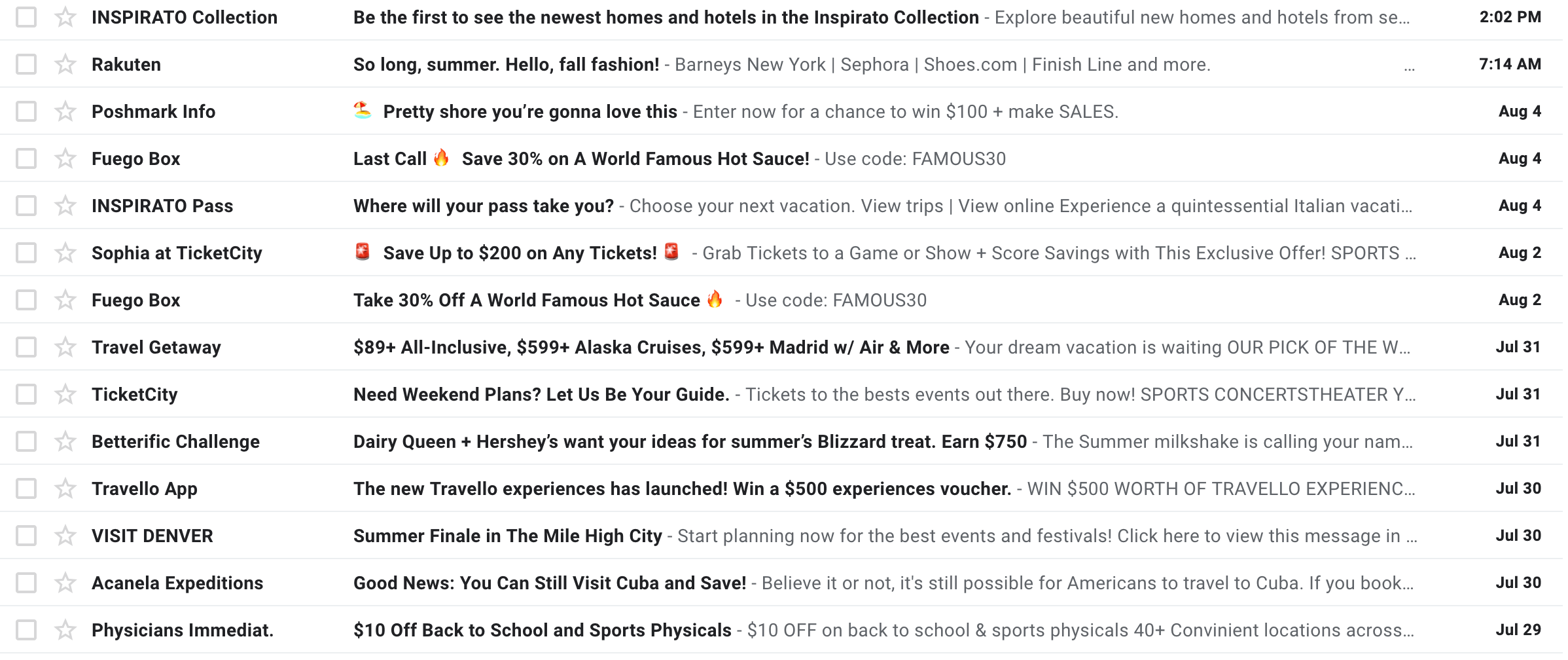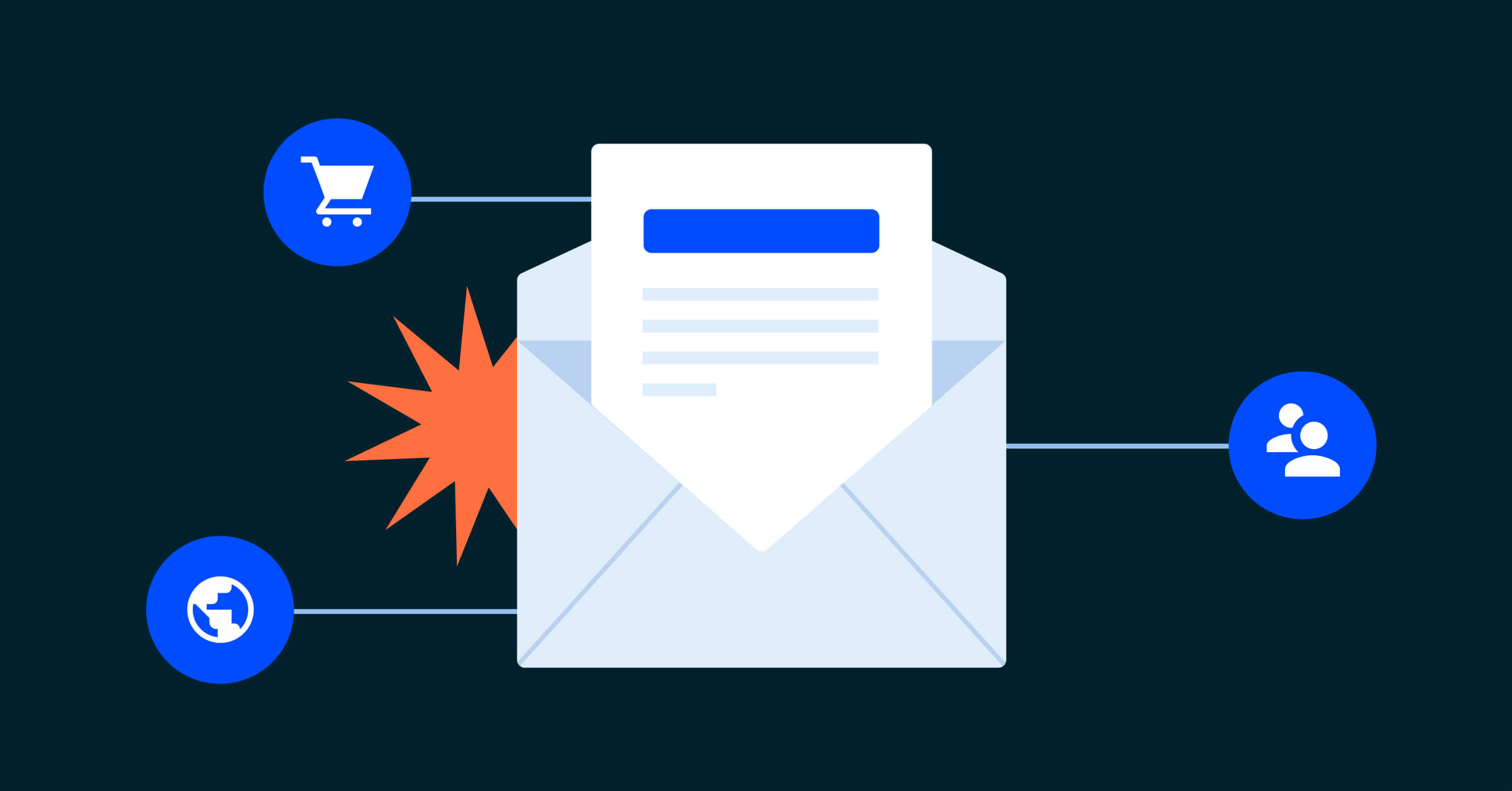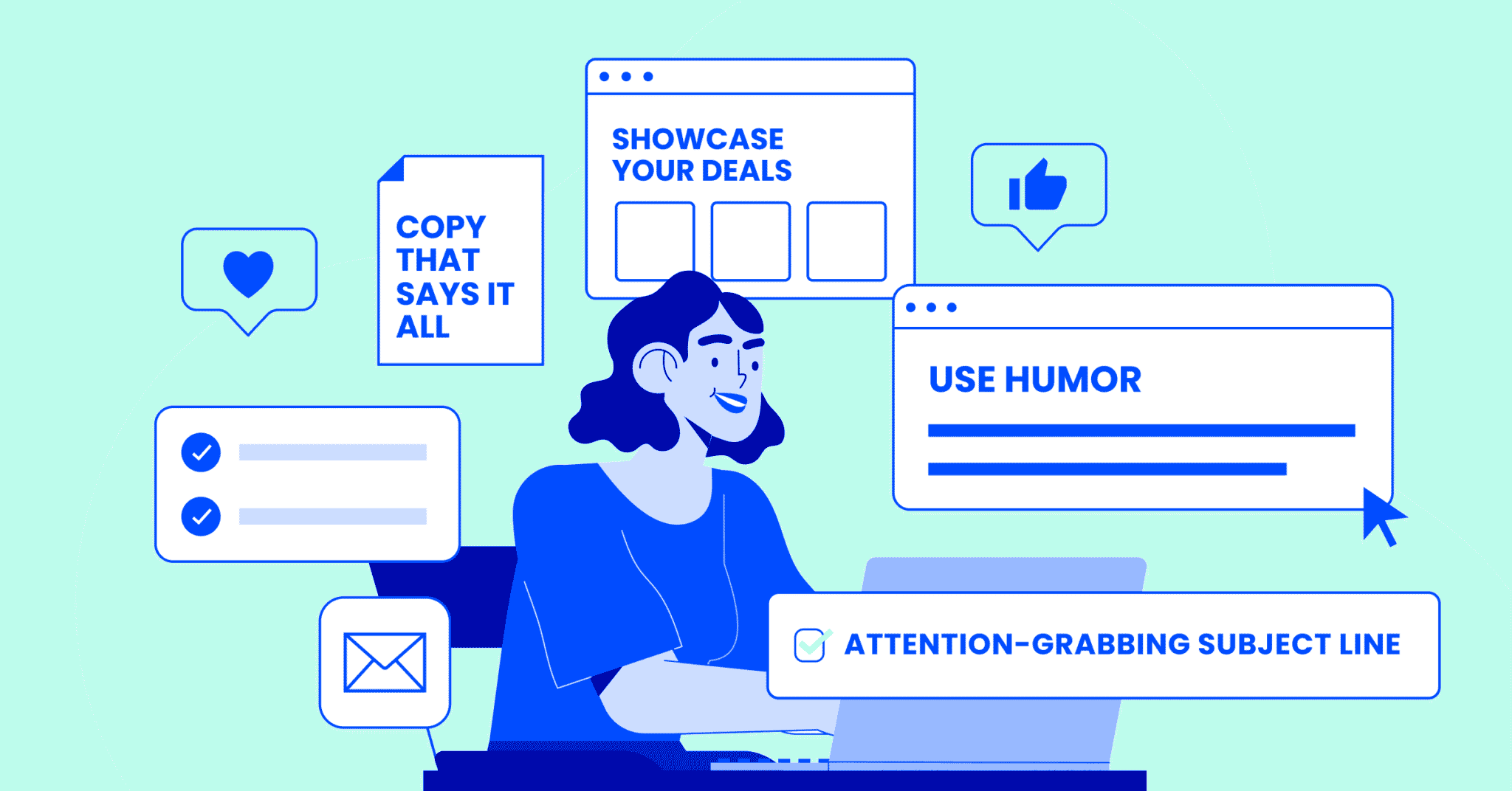Email marketing involves sending emails to customers or (hopefully) soon-to-be customers. When done correctly, it can create strong brand relationships and reinforce existing brand awareness. Consumers feel connected to companies that execute their email marketing campaigns well because email allows for a targeted but human approach.
What is email marketing?
Email marketing is a digital marketing strategy in which a business sends commercial messages, promotional content, or newsletters to a target audience. The communication aims to develop a relationship with prospects or existing customers by generating brand awareness, promoting products or services, and generating more sales.
With the right email marketing campaign strategy, your brand has the opportunity to continuously discover new leads and thanks to automation, those potential customers quickly translate to more subscribers and e-commerce sales without much work on your part.
When it comes to genuine conversions that turn casual shoppers into loyal customers, email is the best of the marketing channels.
After reading our guide, you’ll know how to:
- Create an email list with engaged customers who want to hear from you
- Get those customers to click through to your website regularly
- Automate your marketing pipeline to efficiently turn potential customers into frequent buyers
This page is meant to be used as a reference guide for email marketing. You’ll get a lot out of reading it from top to bottom but you can also use the navigation bar to the right to find the topics you’re most interested in.
Why use email marketing?
Email marketing is a powerful digital marketing strategy that involves sending targeted and personalized emails to a specific audience to promote products and services or nurture relationships. It allows businesses to communicate directly with their customers or prospects, share valuable content, and drive desired actions like sales or engagement.
Here are five reasons why businesses should use email marketing:
- Cost-effective: Email marketing is an affordable way to reach a large audience with minimal investment in time and resources. Many email marketing software platforms offer scalable pricing plans, allowing businesses of all sizes to implement and benefit from email marketing.
- Targeted and personalized communication: Email marketing allows businesses to segment their audience based on various criteria, such as demographics or previous interactions, and tailor marketing emails accordingly. This ensures customers receive content relevant to their needs and interests, leading to higher engagement and conversion rates.
- Measurable results: Email marketing platforms provide a wealth of data, such as open rates, click-through rates, and conversions, which can be analyzed to gauge the success of campaigns and make data-driven improvements. This helps businesses continuously optimize their strategies for better results.
- Strengthen customer relationships: Email marketing is an excellent tool for nurturing customer relationships by providing regular updates, sharing valuable content, and offering personalized promotions. Businesses can foster loyalty and encourage repeat business by consistently engaging with customers through email (as long as they’re not unsolicited emails).
- High return on investment (ROI): According to various studies, email marketing consistently delivers a high ROI compared to other marketing channels. This is primarily due to its cost-effective nature, targeted approach, and ability to drive direct actions such as purchases or sign-ups. By implementing a well-planned email marketing strategy, businesses can experience significant returns on their investment and enjoy successful email marketing campaigns.
In 2020, more than 306 billion emails were sent and received each day worldwide
(Statista, 2020)

What are the benefits of email marketing?
While there are many benefits of email marketing, many of which are specific to each company, the main benefits include improved customer engagement, increased conversion rates, greater retention, customer loyalty, and the ability to be flexible and scale with your needs. Let’s dive into each one of these in more detail.
Improved customer engagement

One of the primary benefits of email marketing is its ability to drive customer engagement by sending targeted and relevant content to your subscribers. These types of emails encourage them to interact with your brand and ultimately lead to higher click-through rates, website visits, and social media engagement.
Email marketing also provides a platform for you to share valuable information, such as industry news, product updates, or educational content. This keeps your audience informed and positions your brand as a thought leader. By delivering content that adds value to your subscribers’ lives, you foster a stronger connection with them and encourage brand loyalty.
Boost conversion rates
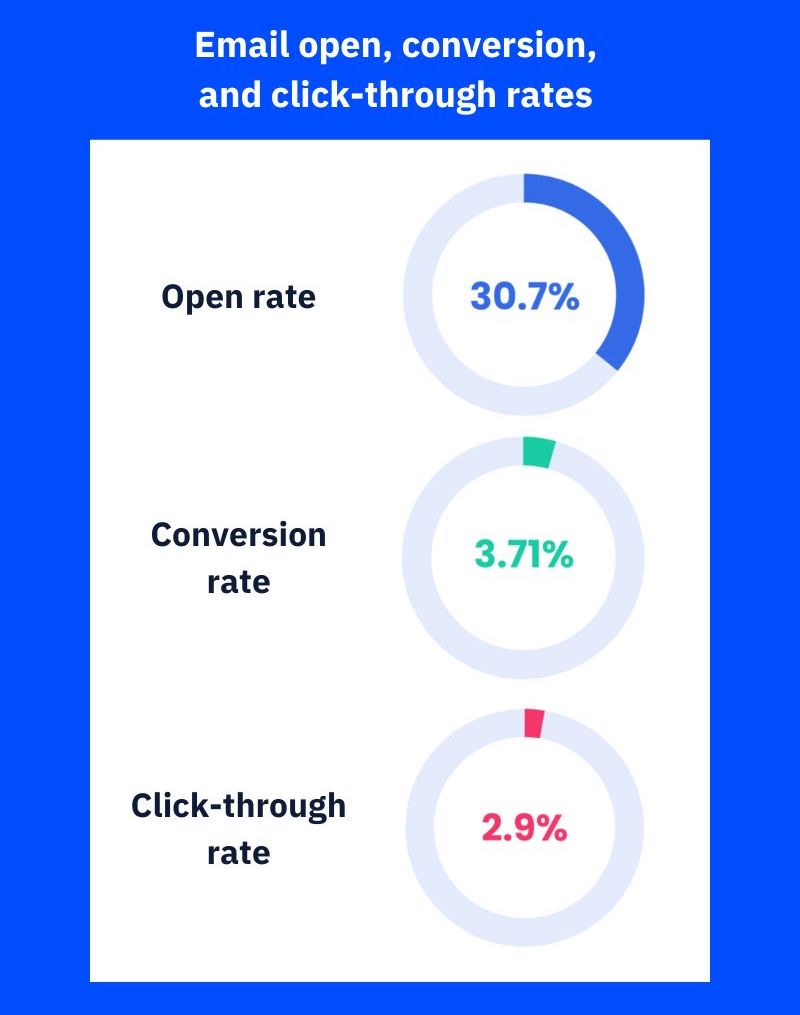
Email marketing is known for its ability to drive conversions, allowing your business to deliver timely and personalized offers to your subscribers. By segmenting your audience based on their preferences, behaviors, or past interactions, you can tailor your messages to cater to their unique needs. This targeted approach can lead to higher conversion rates, as subscribers are more likely to read promotional emails and take action on offers that resonate with them.
Furthermore, email marketing allows for advanced tracking and analysis of user behavior, which helps you to identify trends and optimize your strategy accordingly. This data-driven approach ensures you can continuously improve your email marketing efforts and maximize your conversion potential.
Scalability and flexibility

Businesses of all sizes can benefit from email marketing as these platforms often offer various pricing plans and features to suit different needs. This means that companies can scale their email marketing efforts as they grow without incurring significant additional costs.
Additionally, email marketing allows businesses to test and iterate their strategies quickly and easily. From A/B testing email subject lines to refreshing your template design to trying out different types of email campaigns, businesses can experiment to determine what resonates with their audience and drives results. This flexibility ensures they can continuously optimize their email marketing strategies for maximum impact.
Greater retention and customer loyalty
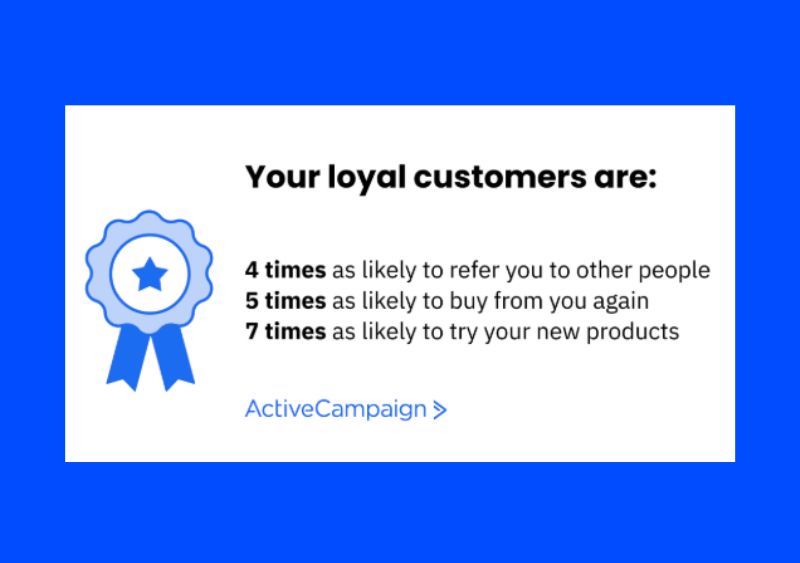
Email marketing plays a crucial role in nurturing customer relationships and fostering loyalty. By consistently engaging with your audience through personalized content, promotions, and updates, you can maintain a strong connection with your customers and encourage repeat business.
By utilizing automation tools, businesses can send targeted emails based on specific triggers, such as a customer’s recent purchase or subscription anniversary. These timely and relevant messages can strengthen the customer-brand relationship and keep your brand top-of-mind, leading to greater retention and loyalty.
Email marketing: step-by-step
Now, let’s learn how to build an email marketing strategy. Below, we provide a step-by-step plan to launch an email marketing campaign for your brand.
Want to jump right into a specific section? Use the links below.
Build an email list
Email marketing centers around your subscriber list. Without a list, there’s nowhere to send your campaigns. Maybe more importantly, if the wrong people are on your list, anything you do send will be ineffective.
Building an email list takes time, but you can do things to speed up the process. Later, we’ll dig into growth tools like lead magnets and opt-in forms to help your list grow faster. For now, just know that having the list and getting the right people on the list is crucial.
Pick an email service provider
Once you have your list started, you’ll need an email service provider (ESP). Great email marketing services offer tools and templates that allow you to break your list up by market segmentation and analyzing critical stats.
Looking at your open rates, click-through rates, and other core metrics will help you optimize your email marketing strategy so your brand continues to grow.
There are several ESPs out there, and they all have slightly different offerings. To make it simple for you, here’s how ActiveCampaign compares to other email clients. That way you can decide which one is best for your company’s goals and needs.
Automate and analyze
Once you have your list and ESP, it comes down to automation and analysis. Your ESP will let you set up autoresponders, which are vital in moving potential customers through your marketing funnel. Essentially, they translate to more profit for less work, but we’ll give them a closer look towards the end of the guide.
By analyzing stats and metrics provided by your ESP, you can tweak your email marketing strategy more effectively. We’ll go over tools like A/B testing to help you optimize customer engagement a little later on.
Want to dive deeper into email marketing? Here is even more free resources.
15 Proven Ways to Grow Your Email List
Welcome Email Series: A 6-Email Welcome Sequence You Can Steal
The Email Campaigns You Should Send Your Customers
250+ Marketing Templates You Can Use Right Now
Automate your email marketing
Alright, you’ve created your email list, you’ve grown it to massive heights, and you’ve optimized your emails to increase open and click-through rates. Now it’s time to consider automation.
Marketing automation will increase conversions and build brand loyalty. It might be your most powerful email marketing tool. Best of all, once you have it set up, it does the work for you.
Dive deeper: Check out our video showcasing a much closer look at email automation and the benefits you can expect from setting up an automation strategy.
In this next section, we’ll tackle:
Autoresponders
An autoresponder is a series of emails triggered by a customer’s specific action. If a subscriber abandons their cart without checking out, for example, you could set up an autoresponder to follow up. It might send an email with a subject line like, “Hey, did you forget something?” and then redirect back to the customer’s cart.
To use an autoresponder, you’ll need to pick a goal first. In the example above, the goal is to minimize cart abandonment.
You also could use an autoresponder for new subscribers to send them a confirmation email and welcome them to your website or community. Maybe it provides a list of your most popular content or simply includes a link to download the lead magnet you promised.
Autoresponders are also perfect for encouraging repeat customers. You can set one so that an email sends a few days, weeks, or months after an initial product purchase. The email might feature a refill at a discounted price or advertise a product accessory the customer might want.
Write autoresponders that convert
With an email sequence outlined, you’re ready to write out your autoresponder. This is where sales-based writing is crucial. You may even want to hire a professional rather than attempt the copy yourself.
If you do decide to give your writing skills a whirl, keep the following in mind:
- The writing isn’t about you; it’s about your reader. It’s about your customer and what value you can bring them. Keeping that front of mind will improve your marketing copy.
- Personalize the emails with more than a name and subject line. Use jargon that the customer segment is familiar with, and cater your website’s features towards the benefits they’re seeking.
- Make sure your subject line is strong. Otherwise, your customers are never opening the email. The subject line may only be a few words, but it can easily take up 80% of your time to develop.
Create an email sequence map
Once you have an autoresponder goal in mind, you need to create an email sequence map. A sequence map is simply a way for you to lay out what emails your customers will receive and when.
You’ll need to consider how long you want your sequence to be and how many emails you want to include. In general, you shouldn’t send these types of email campaigns more than once every two days for educational purposes, but there are exceptions.
For example, during a major sale, it might be appropriate to send three emails in one day, advertising continued price reductions or changing inventory. You should, however, always send more value emails than sales or transactional emails. Value emails provide some sort of value to your customer; maybe a reward, a free tool, or a piece of helpful advice. As a guideline, 80% of your emails should add value; 20% can drive sales directly.
Measure results and adjust
Finally, monitor and evaluate your autoresponder emails regularly. You can use A/B tests to adjust them and improve engagement rates.
The key metrics you should be watching are:
- Click-through rate
- Open rate
- Unsubscribe rates
If your open rates aren’t where you want them to be, focus on your subject lines and timing. Also, make sure the customer segment you’re emailing will find the content you’re sending relevant.
When you see subscribers are opening your emails but not taking action by clicking through to your site, look at your email’s copy. Make sure it’s relevant to your subject line and offers value to the reader.
Lastly, if you see your unsubscribe rate increase, look back at your original goals. Are you delivering what you promised when your customers subscribed?
Unsubscribers are a given and you shouldn’t take it personally. You want your list to be full of engaged customers who want to hear from you. If the unsubscribe rate is substantial, you may need to do some digging to ensure what you promise is what you’re delivering.
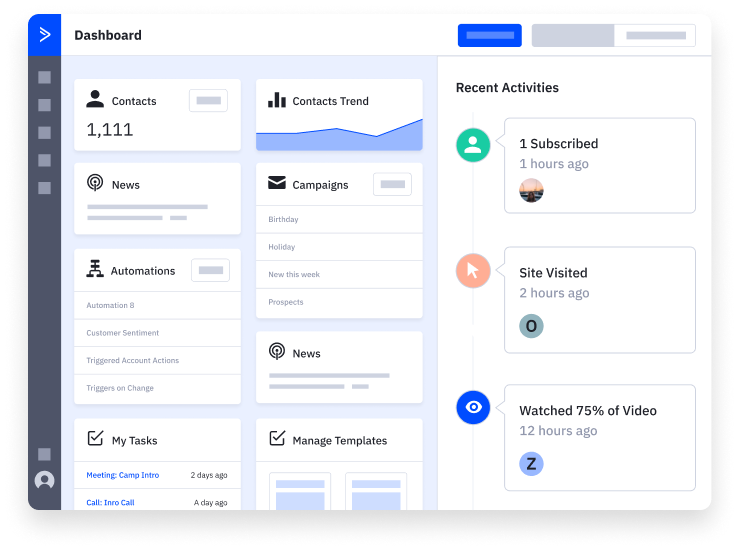
GET STARTED QUICK WITH AUTOMATION TEMPLATES
Create your welcome automation in just a few minutes using ActiveCampaign automation recipes
3 steps to grow your email list
Now that you know the basic steps to email marketing you might have more questions than answers. And what better place to star than the top? Your email list is everything when it comes to email marketing, which means you need to know how to grow one.
Companies will often place a simple opt-in form on their website’s sidebar and consider that enough. It’s not.
To effectively grow an email list, you need to:
- Offer an incentive, such as a lead magnet
- Optimize your opt-in form
- Find the best place for your form
Lead magnets
A lead magnet is an incentive. It’s some sort of offer, typically in the form of a discount, free sample, or digital content that entices potential customers to leave their email address behind.
Some examples of a lead magnet include:
- Ebooks
- Webinars
- Discount or coupon
- Self-assessment quiz
- Free consultation or quote
- Checklist
- Cheat sheet or how-to guide
- Access to exclusive online community
Whatever you choose, it has to be relevant to your business and something your customers want. You might think your grandma’s recipe for chocolate chip cookies is enticing (and it is), but if you’re selling swimsuits, it might not be the best lead magnet.
The best lead magnets include the following three elements.
Instant availability
A lead magnet should be something that lands in the customer’s email inbox. If you have to ship it separately, it won’t have the same effect and probably requires the customer to leave too much personal information. We’re looking for emails, not physical addresses.
Quick to consume
Quick to consume means that your lead magnet is short and easy to digest. If it’s a recipe book, keep it short with five or ten of your top offerings. If it’s a how-to guide, make sure it’s not too lengthy.
Customers who like what they receive can always purchase more in-depth tools and books via your online store. Think of your lead magnet as a useful preview of what you have to offer.
Relevant, useful, and applicable
If it’s quick to consume and the information within it is applicable, your customers will use it to solve their problems. If it works, they’ll fall in love with your brand. They become more than customers. At that point, they’re loyal fans and brand advocates.
You gave them something they could use and may have even needed in return for a simple email address. So subscribers are much more likely to click “open” the next time they see your brand is the sender. They’ll start associating your brand with positive feelings and when they see your name, they’ll know that can trust that whatever you’re offering is relevant and useful.
Optimize opt-in forms
New subscribers respond to lead magnets, but only if you present the lead magnet in an engaging way. Having an attention-grabbing opt-in form is vital to capture potential customers. Opt-in forms should highlight your lead magnet’s benefits. What is the potential subscriber getting out of signing up?
Narrow the benefit down to a simple statement or even a few words, something like: “Free Checklist to Optimize Your Email Marketing Strategy” or “10% Off When You Subscribe”.
Next, make sure your opt-in form has all of the following.
Attention-grabbing visuals
Humans can extract the meaning of an image in about 13 milliseconds, far faster than they can read text. So if you can provide a picture of your lead magnet, do it!
Whether that’s the cover shot of your free ebook or a bright-colored representative graphic, having an attractive photo will help boost conversions.
If you don’t have a picture of your lead magnet, try using a photo of someone reading the opt-in form. Including a human face is always more engaging than showing a static object.
Skimmable details
No one spends long looking at an opt-in form. The second it appears on their screen, your potential customers are probably searching for a way to close it or look around it. But that won’t be the case if it gets its point across quickly.
Visuals are essential for providing meaning at a glance, but bullet-point details can be useful as well. Keep things brief and clear by avoiding full sentences and using action verbs that highlight your lead magnet’s benefits.
Compelling call to action
The subscribe button is the most important part of the opt-in form. You need it to stand out and be quick to find. Use a contrasting color on the button itself and a simple word or call to action like “Subscribe” or “Give Me My Discount.”
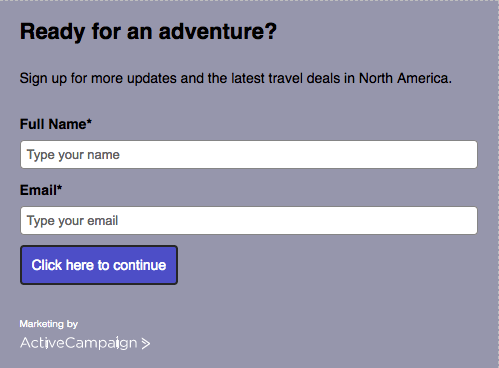
Don’t ask for more customer information than you need. Asking for a first name and email is about the limit. If you ask for last names, birthdays, or other information, your website’s visitors may lose interest and not finish giving you their information. They’ll probably leave your site without subscribing.
That’s information you can ask for down the line once you’ve created a strong relationship with the customer.
Opt-in form placement
Once you have an opt-in form (also called signup forms), there are several places you can put it on your website to maximize conversions. You probably shouldn’t use all of these at once, but picking out a few strategic spots will help you grow your email marketing list.
Ideal placements include:
- Blog header
- Landing pages
- Blog archive pages
- Sidebar
- Within blog posts
- Timed popups
- Scroll boxes
- Footer
- About us page
Some of the most effective opt-in forms show up as timed popups. Website users will get annoyed if you overuse this tactic, but a well-timed popup can work wonders.
Getting a visitor to subscribe to your email list is easier if you’ve already engaged them with your site’s content. Timed popups allow users to engage first and only include a signup form once the user has shown interest by browsing your site for a set period of time.
Remember, the key to good email marketing is having a list full of people who want to be on it. Having a signup form ensures that you won’t end up spamming people. Not using too many popups for your opt-in form is also better than going overboard.
Email marketing best practices
As you dive deeper into email marketing, here are four tips that the top ActiveCampaign customers use to get the most from their emails.
Feel free to jump ahead using these links:
Avoid spam filters
If your emails are ending up in the spam folder, your customers aren’t seeing them. There are a few things you can do to help avoid this fate.
- First, ensure that everyone on your list opted in. If they didn’t, you’re spamming them (and that could result in spam complaints). That’s not only a bad business practice, but it’s also potentially illegal. Assuming that’s not the case, you want to make sure you’re sending from a good IP address. If the IP address has been flagged for spamming in the past, email servers will flag it again.
- When picking an email template from your ESP, make sure you keep the coding clean and personalize the “To” field with merge tags if you can. A vague “To: Valued Subscribers” could cause the email to go to the spam box. You want to ensure your email includes your company or brand location and makes it easy to unsubscribe. Most reliable ESPs will take care of this part for you, but it’s good to be aware of the process they require.
- Lastly, educate your audience on how to add your company or brand to their address book. That’s the surest way to avoid the spam filter. If your customers are engaged and looking for your emails, they’ll have no issue taking this extra step.
Create eye-catching subject lines
We touched on subject lines earlier under A/B testing, but we didn’t delve into what makes a subject line great. Just like the first line of a book or movie, a subject line needs to create intrigue. It should have your customers asking a question right from the start. Their curiosity will lead them to open your email and hopefully click through to your website.
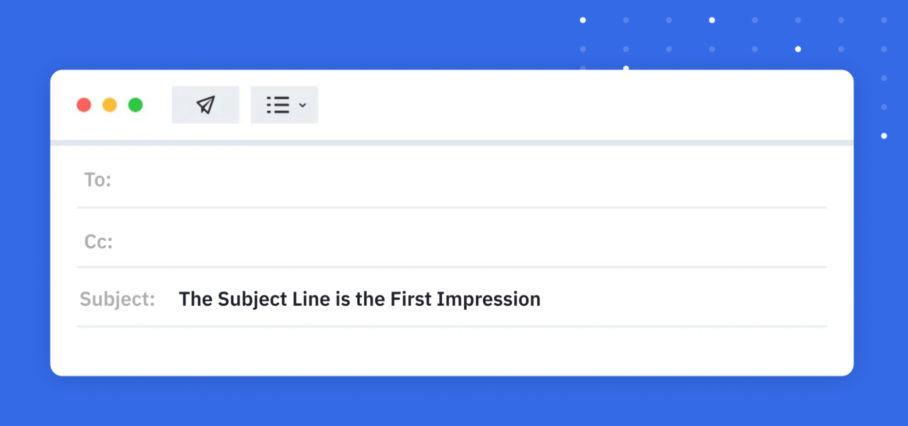
However, there’s a caveat to creating curiosity. You can’t be so vague that you leave your customer frustrated. It’s a delicate balance between giving them a little but not too much. A/B testing is very helpful in figuring the balance out.
In general, subject lines that feature a conversational tone do best. Write as if you’re talking to a friend. And, if you can, try to include numbers. It will make your subject line stand out in a cluttered inbox.
Get your customers hooked by using our free email subject line generator.
Personalize your emails
Part of effective writing involves knowing your audience. It’s tempting to think of thousands of people reading your email newsletters, but remember those thousands aren’t sitting in a room together. Each one is by themselves in front of a screen.
So really, your audience is one individual at a time. Write as if you’re talking to one person because you are.
You can personalize using your email marketing tool’s merge tags. With them, you can insert details like the customer’s first name, which helps it seem like you’re speaking solely to them even when it’s an email for a large customer segment.
Optimize for mobile
Many of us check our emails multiple times a day, but not necessarily on a desktop. More often than not, we’re messaging on our mobile devices. So, you need to optimize your marketing emails for mobile viewing if you’re going to maximize open and click-through rates.
To do this:
- Use fast-loading media. Don’t bog down your emails with giant photos or graphics, which could limit email deliverability.
- Don’t rely on pictures to be displayed. Android, for example, removes email images by default for faster loading.
- Make sure any call-to-action buttons are large and away from any other links. Think of someone navigating your email with a thumb on their phone screen. Two links close together can lead a customer to the wrong place.
Frequently asked questions
How do I choose an email service provider?
There are many email marketing platforms out there, and they offer services that range from free to relatively expensive. What your company needs has to do with the size of your brand and your marketing budget.
Here are eight questions you should ask yourself before choosing an email service provider:
- How intuitive and easy-to-set-up is it?
- Has this provider been around for a while?
- How often do they update their platform? (This can be both good and bad)
- How many options do they have for email design and templates?
- What type of email and marketing automation is available?
- What type of payment structure do they use?
- Who is their ideal customer (is it you)?
- Does it track revenue and tie into your CRM?
Ready to get started with email marketing?
Whether you own a small business or work for a larger company, using targeted emails is a cost-effective way to improve your conversion rate. Email marketing will help you build a long-term relationship with your customers that translates to better bottom lines.
You can use email for advertising a new product or promote epic pricing on your online store. More importantly, you can connect directly to your email subscribers. With personalized and valuable information, your customers will become more than one-time buyers; they’ll become brand loyalists.
If you’re ready to become a full fledged email marketer, start your free trial with ActiveCampaign by entering your email address below! Let’s craft that first email today.
Jump to a section

